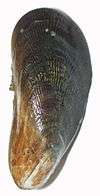Geukensia demissa
| Geukensia demissa | |
|---|---|
 | |
| Scientific classification | |
| Kingdom: | Animalia |
| Phylum: | Mollusca |
| Class: | Bivalvia |
| Subclass: | Heterodonta |
| Order: | Mytiloida |
| Family: | Mytilidae |
| Subfamily: | Mytilinae |
| Genus: | Geukensia |
| Species: | G. demissa |
| Binomial name | |
| Geukensia demissa (Dillwyn, 1817) | |
| Synonyms | |
|
Modiolus demissus (Dillwyn) | |
Geukensia demissa is a species of mussel, a marine bivalve mollusk in the family Mytilidae, the true mussels. This species is native to the Atlantic coast of North America. The common names for this species include ribbed mussel, Atlantic ribbed marsh mussel and ribbed horsemussel.[1] However, the common name ribbed mussel is also used for the Southern Hemisphere mussel Aulacomya atra. The appearance of the shell is grooved and oval in shape. The interior of this mussel is tinted purple
The ribbed shells of this species usually attain a length of 10 cm length, and can be as large as 13 cm.[1] Age can be determined by counting dark growth rings on the shell and mussels typically live 10 – 15 years, but more advanced ages are not uncommon.[2]
Distribution
The ribbed mussel occurs in the coastal waters of salt marsh habitats from the southern Gulf of St. Lawrence in eastern Canada south along the western Atlantic coast to Florida. In the Gulf of Mexico this species is replaced by the southern ribbed mussel, Geukensia granosissima. Geukensia granosissima and Geukensia demissa hybridize in southern Florida.[3]
The ribbed mussel has been introduced to Texas, Mexico, California, and Venezuela.[1]
Habitat
Ribbed mussels live in the intertidal zone, attached to hard surfaces or embedded in sediment with the help of their byssal threads. They are typically found in salt marshes where they form dense aggregations with the marsh cordgrass (Spartina alterniflora) and each other.[4]
Reproduction
Ribbed mussels are dioecious and sexes can only be determined histologically.[5]
They reproduce once per year in Connecticut[5] and South Carolina,[6] however in an introduced population in Venezuela two spawning peaks have been observed.[7]
Mussels >20 mm are typically reproductive, however it is not uncommon for mussels up to 35 mm to have no signs of gametogenesis.[8]
Diet
The Ribbed Mussel is primarily a filter feeder for the Rhode Island bay area. They help to clean said area of bacteria, parasites, and heavy metals.[9]
References
- 1 2 3 Geukensia demissa (mollusc) Global Invasive Species Database.
- ↑ Brousseau, Diane J. (1984-01-01). "Age and Growth Rate Determinations for the Atlantic Ribbed Mussel, Geukensia demissa Dillwyn (Bivalvia: Mytilidae)". Estuaries. 7 (3): 233–241. doi:10.2307/1352143. JSTOR 1352143.
- ↑ Sarver, S. K.; Landrum, M. C.; Foltz, D. W. "Genetics and taxonomy of ribbed mussels (Geukensia spp.)". Marine Biology. 113 (3): 385–390. doi:10.1007/BF00349163. ISSN 0025-3162.
- ↑ Bertness, Mark D.; Grosholz, Edwin (1985-09-01). "Population dynamics of the ribbed mussel, Geukensia demissa: The costs and benefits of an aggregated distribution". Oecologia. 67 (2): 192–204. doi:10.1007/BF00384283. ISSN 0029-8549.
- 1 2 Brousseau, Dianna (1982). "Gametogenesis and spawning in a population of Geukensia demissa from Westport ,Connecticut". The Veliger.
- ↑ Borrero, Francisco J. (1987-08-01). "Tidal Height and Gametogenesis: Reproductive Variation Among Populations of Geukensia Demissa". The Biological Bulletin. 173 (1): 160–168. doi:10.2307/1541869. ISSN 0006-3185.
- ↑ "Reproductive cycle of Geukensia demissa (Bivalvia: Mytilidae) on a beach at Nazaret, El Moján, Zulia State, Venezuela". ResearchGate. Retrieved 2016-04-10.
- ↑ Franz, David (1996). "Size and age at first reproduction of the ribbed mussel Geukensia demissa in relation to shore level in a New York salt marsh". Journal of Experimental Marine Biology and Ecology. doi:10.1016/s0022-0981(96)02607-x.
- ↑ https://www.edc.uri.edu/restoration/html/gallery/invert/ribbed.htm
- Geukensia demissa (Dillwyn, 1817) World Register of Marine Species (2012)
- Loren Coen and Keith Walters Ribbed Mussel Geukensia demissa South Carolina Department of Natural Resources
- http://www.sms.si.edu/irlspec/Geukensia_demissa.htm